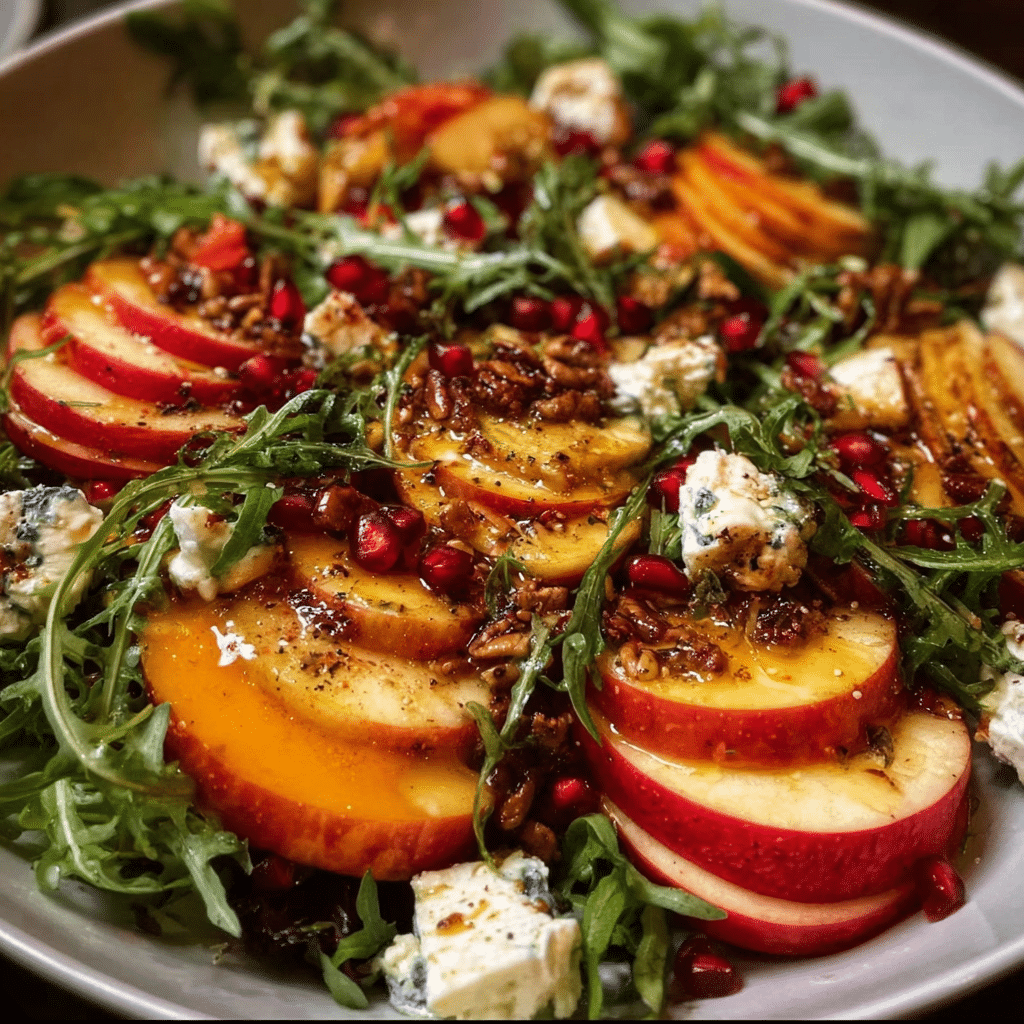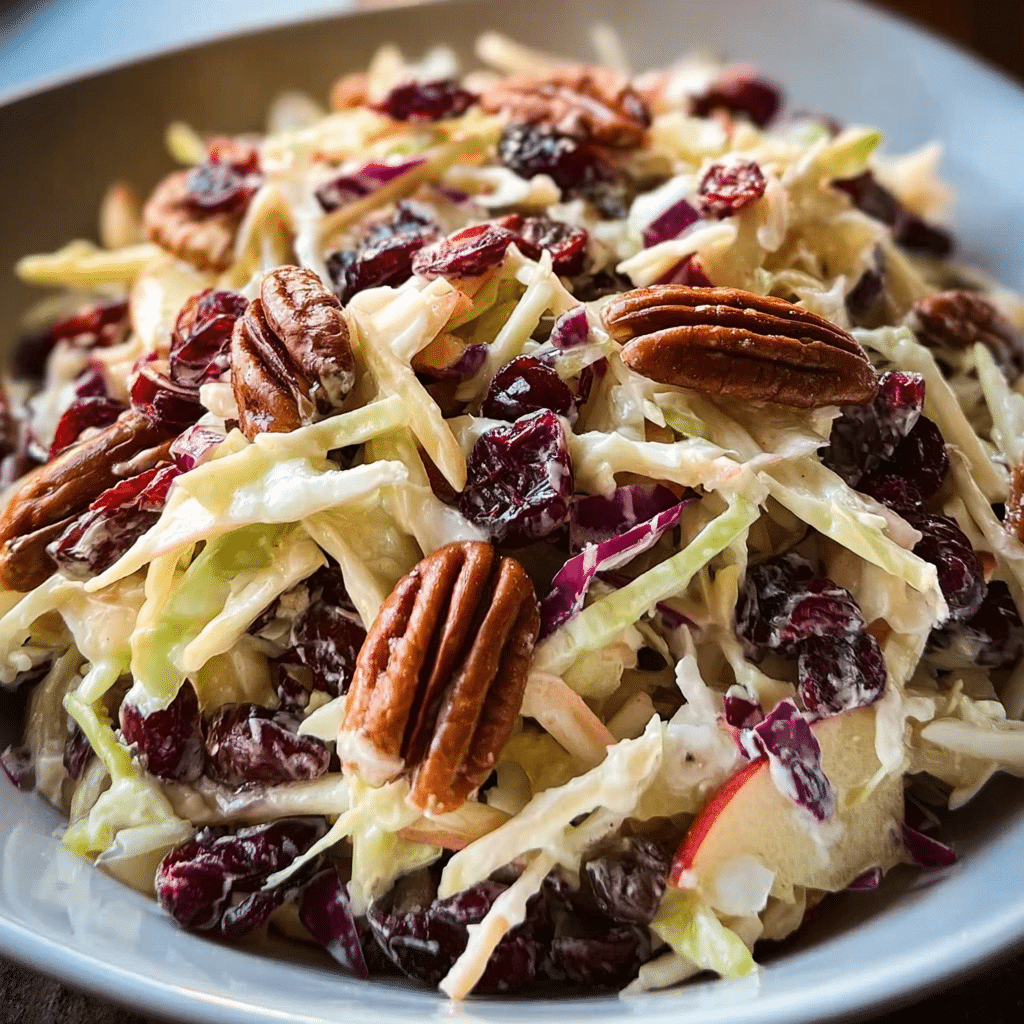Roasted butternut squash has quickly become one of my favorite ingredients, transforming simple meals into gourmet experiences. I remember the first time I encountered this vibrant orange beauty at a local farmer’s market. The air was crisp, leaves were starting to change color, and the rich scent of autumn was undeniable. I was drawn to a stall overflowing with various squashes, but the butternut caught my eye with its smooth skin and inviting shape. I was intrigued and knew I had to take one home.
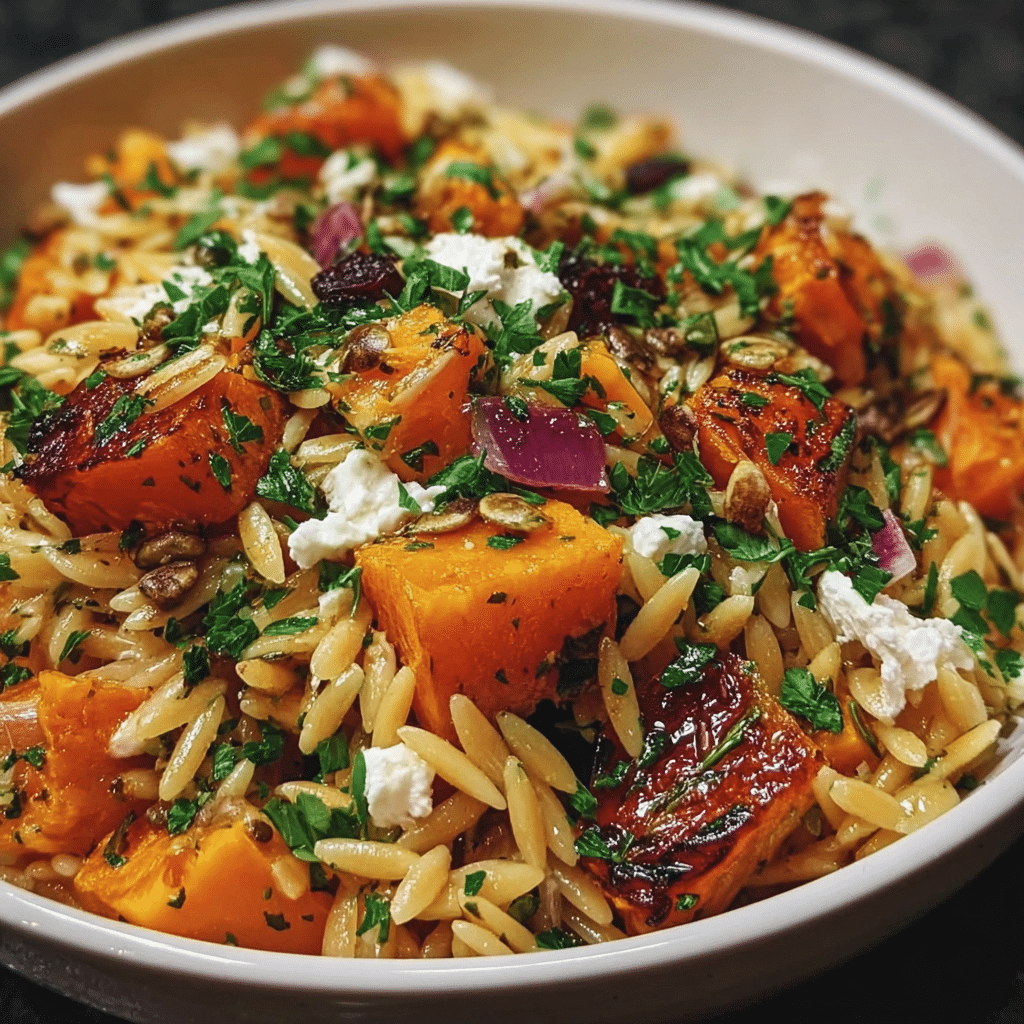
That evening, armed with a few basic ingredients, I set out to create a dish that would highlight the squash’s natural sweetness. I roasted it with olive oil, salt, and a sprinkle of cinnamon, and the result was nothing short of magical. The sweet, caramelized flavor of the roasted butternut squash was unlike anything I had tasted before, and it inspired me to experiment further. It wasn’t long before I stumbled upon the idea of combining it with orzo—a delightful pasta that complements the squash perfectly. I created what would become my go-to recipe: roasted butternut squash orzo salad.
The Story Behind This Recipe
This recipe is not just about the ingredients; it’s a reflection of cozy family dinners and the joy of sharing food with loved ones. Roasted butternut squash orzo salad has become a staple in our household, especially during the fall months when the harvest is at its peak. It’s a dish that brings comfort and warmth, evoking memories of family gatherings and laughter around the table.
What makes this recipe special is its versatility. Whether you’re serving it as a side dish at a holiday feast or as a quick weeknight dinner, the roasted butternut squash orzo salad is adaptable enough to suit any occasion. You can add in your favorite proteins, toss in some greens, or even enhance it with nuts and cheese. The flavor profile is rich and diverse, making it a family favorite that pleases everyone.
Why You’ll Love This Dish
This dish is perfect for busy families looking for quick dinner solutions. The beauty of roasted butternut squash orzo salad lies in its simplicity. With minimal prep time and a relatively short roasting period, you can have a nutritious and delicious meal on the table in under an hour. It’s a lifesaver on those hectic weeknights when you want something wholesome yet easy to prepare. You can roast the squash ahead of time, making it even more convenient for quick assembly later in the week.
Seasonal relevance is another reason to embrace this dish. Butternut squash is typically harvested in the fall, making it a hallmark of autumn cooking. As the weather turns cooler, the rich, earthy flavor of roasted butternut squash is not only comforting but also a celebration of the season’s bounty. I find joy in preparing this dish when the days grow shorter, and the air turns brisk, as it captures the essence of fall on a plate.
Emotionally, this dish holds a special place in my heart. It’s a reminder of family meals, laughter, and the warmth of sharing food with those we love. There’s something about the colors and flavors that brings a sense of joy and nostalgia. Every time I serve roasted butternut squash orzo salad, I feel a connection to my roots and the traditions of home cooking that have been passed down through generations.
In this guide, you will learn not only how to prepare roasted butternut squash orzo salad but also gain insights into its rich history and cultural significance. You will discover the nutritional benefits of butternut squash, tips for perfecting the dish, and how to make it your own. By the end of this article, you will be inspired to bring this delightful dish into your kitchen, filling your home with the flavors of the season and the warmth of family gatherings.
The Rich History and Cultural Significance of roasted butternut squash
The rich history and cultural significance of roasted butternut squash are as layered and complex as the flavors it brings to our plates. This humble vegetable has roots that trace back thousands of years, originating in the Americas. The butternut squash, known scientifically as Cucurbita moschata, was cultivated by indigenous peoples long before European settlers arrived. Its origins lie in Central America, where it was not only a staple food but also a significant part of the cultural fabric.
Origins and History
As settlers made their way across the continent, they encountered this versatile squash and adopted it into their culinary repertoire. The butternut squash became a popular choice due to its long shelf life and nutritional benefits, allowing it to be stored and consumed throughout the winter months. It was often prepared in various ways, from roasting and baking to soups and stews, showcasing its adaptability.
Over the years, roasted butternut squash has evolved from a simple, hearty food to a gourmet ingredient featured in upscale restaurants and home kitchens alike. Chefs began to experiment with flavors, pairing it with spices, herbs, and other seasonal ingredients, leading to the creation of dishes that celebrate its unique taste. This evolution reflects a broader trend in culinary arts, where traditional ingredients are reimagined to suit contemporary palates while honoring their historical roots.
Cultural Significance
Roasted butternut squash holds a special place in various culinary traditions, particularly in North American and Latin American cuisines. In many households, it is synonymous with comfort food and is often featured during Thanksgiving, embodying the spirit of gratitude and abundance. The dish is also popular in autumn festivals, where communities celebrate the harvest and the changing of the seasons. Its warm, inviting flavors make it a favorite during cooler months, fostering a sense of togetherness and celebration.
Famous chefs around the world have embraced roasted butternut squash, showcasing it in innovative ways. Renowned figures in the culinary scene have created dishes that elevate this simple vegetable to new heights, pairing it with exotic spices or incorporating it into elegant presentations. Restaurants often feature it as a seasonal special, highlighting its versatility and flavor while appealing to diners seeking a taste of fall.
Nutritional Benefits
Not only is roasted butternut squash delicious, but it also boasts an impressive nutritional profile. Rich in vitamins A and C, it supports eye health and boosts the immune system. Additionally, it provides a good source of dietary fiber, which aids in digestion and promotes a feeling of fullness—making it an excellent choice for those looking to maintain a healthy diet.
Furthermore, butternut squash is low in calories but high in essential nutrients, including potassium and magnesium. This combination makes it a fantastic addition to any meal, providing a nutritious boost without unnecessary calories. As families seek healthier dinner options, roasted butternut squash emerges as a clear winner, marrying taste and nutrition in one beautifully simple dish.
In summary, the story of roasted butternut squash is a rich tapestry woven from history, culture, and nutrition. From its ancient roots to modern kitchens, it has remained a beloved ingredient, celebrated for its versatility and flavor. Understanding its background and significance not only enhances our appreciation of this dish but also connects us to the generations that have come before us, bringing warmth and comfort to our tables.
Essential Ingredients for Perfect roasted butternut squash
Essential Ingredients for Perfect Roasted Butternut Squash
When it comes to crafting a delightful Roasted Butternut Squash Orzo Salad, the ingredients play a vital role in ensuring that each bite bursts with flavor and texture. Selecting the right components not only enhances the dish but also elevates your culinary experience. Below, I’ll walk you through each essential ingredient, providing insights on their importance, quality indicators, and tips for making the best choices.
Essential Ingredients
- 1 medium butternut squash, peeled, seeded and cut into 1-inch chunks: This is the star of the show! Look for a squash that feels heavy for its size, with a smooth, firm skin. The flesh should be bright orange, indicating ripeness. Roasting enhances its natural sweetness, making it a perfect base for the salad.
- 1 tablespoon olive oil: A high-quality extra virgin olive oil adds richness to the dish. Choose oil with a fruity aroma and a peppery finish for maximum flavor. Look for cold-pressed varieties if possible.
- Kosher salt and pepper, to taste: These are essential for enhancing the flavors of the ingredients. Kosher salt is preferred due to its texture and ease of use. Freshly cracked black pepper adds a wonderful kick. Always season as you go for the best results.
- 1 cup orzo: This small pasta shape adds a delightful chewiness to the salad. Opt for whole wheat or gluten-free versions if you’re looking for healthier or allergen-friendly options.
- 5 oz spinach: Fresh spinach provides a vibrant color and a nutritious boost. Choose bright green leaves without any wilting or browning. Baby spinach is tender and a delicious addition.
- 4 oz crumbled goat cheese, or feta cheese: The tangy creaminess of goat cheese complements the sweetness of the roasted butternut squash beautifully. If you’re not a fan of goat cheese, feta is a great alternative, offering a similar texture and flavor profile.
- 1/2 cup pepitas: These pumpkin seeds add a lovely crunch and nutty flavor to the salad. Look for raw or roasted pepitas, depending on your preference. They are packed with nutrients and healthy fats.
- 1/2 cup dried cranberries: Sweet and chewy, dried cranberries bring a pop of color and a hint of tartness. Choose unsweetened or lightly sweetened varieties for a healthier option.
- 1/3 cup chopped red onion: Red onion adds a sharp, zesty crunch to the salad. Choose firm onions with a vibrant color. If the flavor is too strong for you, soaking them in cold water for a few minutes can mellow their bite.

Roasted Butternut Squash Orzo Salad
Ingredients
For the salad:
- 1 medium butternut squash, peeled, seeded and cut in 1-inch chunks
- 1 tablespoon olive oil
- Kosher salt and pepper, to taste
- 1 cup orzo
- 5 oz spinach
- 4 oz crumbled goat cheese, or feta cheese
- 1/2 cup pepitas
- 1/2 cup dried cranberries
- 1/3 cup chopped red onion
For the dressing:
- 1/3 cup olive oil
- 2 tablespoons red wine vinegar
- 1 tablespoon pure maple syrup or honey
- 1 teaspoon Dijon mustard
- 1 clove garlic, minced
- 1/4 teaspoon ground cinnamon
- Kosher salt and black pepper, to taste
Instructions
- Preheat oven to 400 degrees F.
- Place the squash on a large baking sheet and drizzle with the olive oil. Toss until well coated. Season with salt and pepper. Arrange the squash in one layer and roast for 25 to 30 minutes, until the squash is tender, turning once with a spatula.
- While the squash is roasting, cook the orzo according to package instructions. Drain and rinse under cold water. Drain well.
- Pour the cooked orzo into a large bowl. Add the roasted butternut squash, spinach, goat cheese, pepitas, and dried cranberries.
-
In a small bowl or jar, whisk together the olive oil, vinegar, maple syrup (or honey), mustard, garlic, cinnamon, salt, and pepper.
-
Pour the dressing over the salad and toss until well combined. Season with salt and pepper, to taste. Serve immediately.
Shopping Tips
When shopping for ingredients for your roasted butternut squash orzo salad, seasonality matters. Butternut squash is generally in season from late summer through winter, so it’s best to buy it during this period for peak flavor and quality. For other ingredients, aim to purchase fresh produce from local farmers’ markets when possible to ensure you’re getting the best quality available. Look for organic options whenever you can, especially for items like spinach and goat cheese, as they can often be found with fewer additives and pesticides.
Substitutions and Alternatives
If you have dietary restrictions or simply want to switch things up, there are plenty of substitutions for this recipe. For the butternut squash, sweet potato or acorn squash can be excellent alternatives, providing a similar sweetness and texture. If you’re looking for a gluten-free option for the orzo, consider using quinoa or rice. In place of goat cheese, try using vegan cheese or omit it altogether for a lighter salad. For added protein, grilled chicken or chickpeas can be tossed in as well. When it comes to pepitas, sunflower seeds or sliced almonds can add a lovely crunch as well.
In terms of storage, raw butternut squash can be kept in a cool, dark place for several weeks. Once cut, store it in the refrigerator for up to a week. Spinach should be used within a few days of purchase for the best taste. For cheese, keep it refrigerated and tightly wrapped to maintain freshness. Dried cranberries can be stored in a cool, dark place and can last for several months. By following these tips, you can ensure that your ingredients remain fresh and flavorful for your roasted butternut squash orzo salad.
Detailed Step-by-Step roasted butternut squash Cooking Instructions
Detailed Step-by-Step Roasted Butternut Squash Cooking Instructions
Now that we have our ingredients prepped and ready, it’s time to dive into the cooking process. Making a roasted butternut squash orzo salad involves several steps, but don’t let that intimidate you. With a little organization and a clear plan, you’ll create a stunning dish that’s full of flavor and nutrition. Let’s break down the process step by step.
Preparation Steps
- Preheat your oven: Start by preheating your oven to 400°F (200°C). A hot oven is crucial for roasting the butternut squash, allowing it to caramelize and develop its sweet, nutty flavor.
- Prepare the butternut squash: Carefully peel the squash using a vegetable peeler, then cut it in half lengthwise to scoop out the seeds. Cut the squash into 1-inch chunks, ensuring they are uniform in size for even cooking. This step not only enhances the aesthetic appeal but also ensures consistent roasting.
- Season the squash: In a large bowl, toss the butternut squash chunks with olive oil, kosher salt, and pepper. Make sure each piece is evenly coated. This is where the flavor begins to build, so be generous with your seasoning!
- Roast the squash: Spread the seasoned butternut squash on a baking sheet in a single layer. This allows for proper airflow and even roasting. Bake for about 25 minutes, or until the edges are golden brown and the squash is tender when pierced with a fork. You’ll know it’s done when it smells heavenly!
Cooking Process
- Cook the orzo: While the squash is roasting, bring a pot of salted water to a boil. Add the orzo and cook according to package instructions, usually about 8-10 minutes. Stir occasionally to prevent sticking. Once cooked, drain the orzo and rinse it under cold water to halt the cooking process and help it maintain its texture.
- Prepare the dressing: In a small bowl, whisk together the olive oil, red wine vinegar, pure maple syrup or honey, Dijon mustard, minced garlic, ground cinnamon, and a pinch of salt and pepper. Taste and adjust the seasoning as needed. This dressing is the magic that ties all the flavors together, so don’t skip this crucial step!
- Combine the ingredients: In a large mixing bowl, combine the cooked orzo, roasted butternut squash, fresh spinach, crumbled goat cheese or feta, pepitas, dried cranberries, and chopped red onion. Gently toss to mix everything together, being careful not to break the cheese or squash pieces.
Final Assembly
- Add the dressing: Drizzle the dressing over the salad and toss gently to combine. The warmth from the butternut squash will slightly wilt the spinach, creating a lovely texture.
- Adjust seasoning: Before serving, taste the salad and adjust the seasoning if necessary. A little extra salt or a sprinkle of freshly cracked pepper can make a world of difference.
- Serve and enjoy: Transfer the salad to a serving platter or individual bowls. This roasted butternut squash orzo salad is best served warm but can also be enjoyed at room temperature. It’s a perfect dish for potlucks, gatherings, or a cozy family meal. The vibrant colors and textures make it visually appealing, while the combination of flavors will leave everyone wanting more!
Throughout this process, keep an eye on your timing. The entire cooking time is around 30 minutes, making it a quick yet impressive dish. By following these detailed instructions, you’ll not only learn how to create a delicious roasted butternut squash orzo salad but also gain confidence in your cooking skills. Enjoy the journey and the delectable results!
Professional Tips and Techniques for roasted butternut squash
When it comes to preparing a delightful dish like roasted butternut squash orzo salad, mastering the art of roasting butternut squash is essential. It’s not just about tossing it in the oven and hoping for the best; it’s a culinary dance that deserves attention! Over the years, I’ve learned a few professional tips and techniques that elevate this beautiful fall vegetable from a simple side to a star ingredient in salads and beyond.
Professional Techniques
To achieve the perfect roasted butternut squash, start by selecting a squash that feels heavy for its size with a smooth, firm skin. This indicates ripeness and optimal sweetness. Once you’ve chosen your squash, it’s crucial to cut it properly. I recommend peeling it first; although some chefs argue against peeling, I find that the texture improves when the tough skin is removed. Use a sturdy vegetable peeler or a sharp knife to ensure safety and efficiency.
Next, you’ll want to cube the squash into uniform pieces. This not only helps with even cooking but also makes for a more appealing presentation in your orzo salad. Aim for 1-inch cubes; they roast beautifully, caramelizing on the outside while remaining tender inside. As you chop, remember that the more uniform the pieces, the better they will cook together.
To enhance flavor and texture, toss the cubes in a mixture of olive oil, salt, and pepper. This is where you can get creative—consider adding garlic powder, smoked paprika, or even a pinch of cayenne for a kick. The key is to coat them evenly, which I find is best achieved when you use your hands. This also gives you a chance to feel the squash and check for any imperfections!
When it comes to roasting, spread the cubes out in a single layer on a baking sheet. If they are too crowded, they will steam rather than roast, resulting in an unappetizing mush. Roast at 400°F for about 25-30 minutes, or until they are golden brown and tender. Halfway through, give them a stir to ensure they are roasting evenly. The aroma that fills your kitchen during this time is simply divine!
Troubleshooting Guide
Even with the best intentions, things can occasionally go awry. If your roasted butternut squash turns out mushy, it’s most likely due to overcrowding on the baking sheet or using too low a temperature. Aim for that crispy exterior that makes roasted vegetables so appealing! If it’s burnt on the outside and raw on the inside, you might have cut the pieces too large or placed them too close to the heat source. Adjusting the size of your cubes can help; smaller pieces roast faster.
Another common issue is flavor. If your roasted butternut squash lacks that sweet, caramelized taste, consider extending the cooking time or increasing the temperature slightly. A sprinkle of brown sugar or maple syrup just before roasting can also bring out that natural sweetness!
Presentation Tips
Once your roasted butternut squash is perfectly cooked, presentation becomes key, especially when serving it in an orzo salad. I love to arrange the cubes in a colorful bowl, contrasting them with the golden orzo, fresh greens, and perhaps some pomegranate seeds for a burst of color. Drizzling a balsamic reduction over the top adds a touch of elegance and acidity, balancing the sweetness of the squash beautifully.
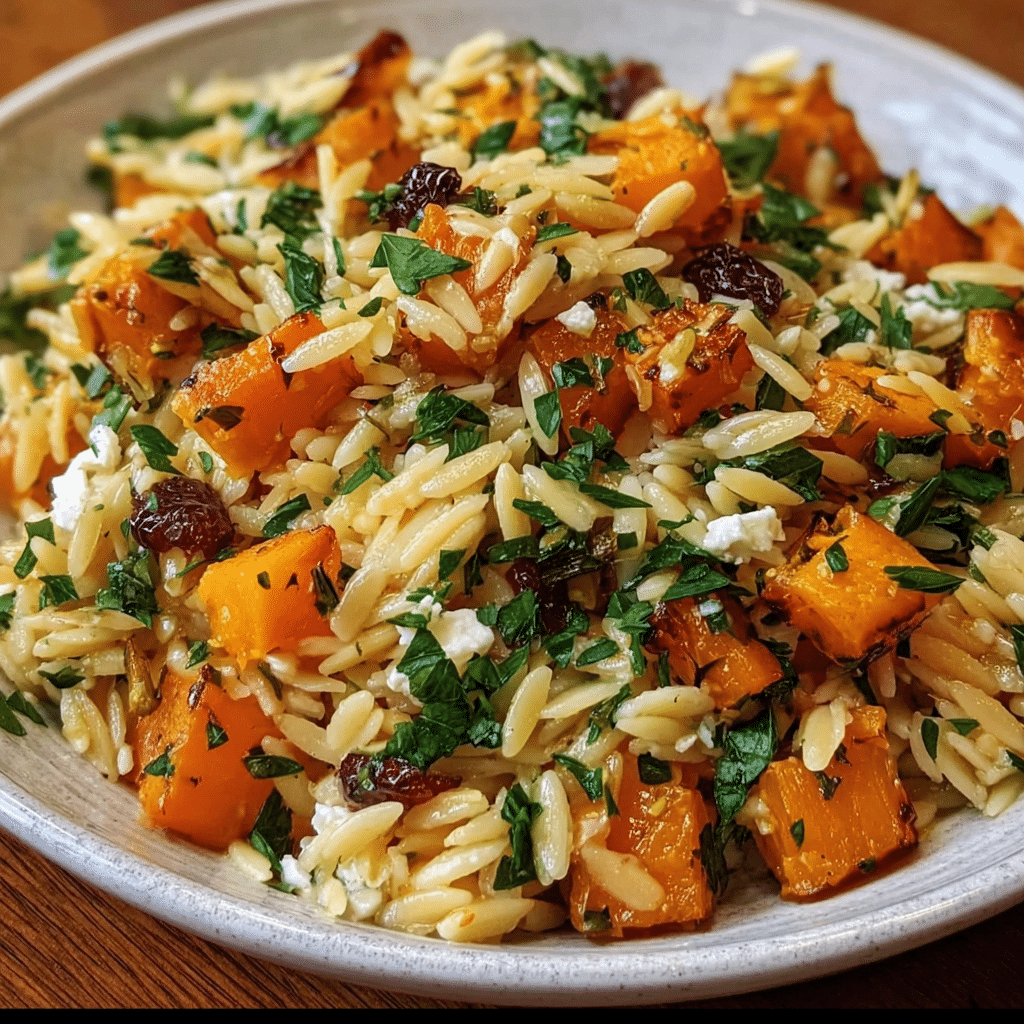
For a finishing touch, sprinkle some freshly chopped herbs like parsley or sage. Not only do these add flavor, but they also enhance the visual appeal of your dish. If you’re feeling particularly fancy, serve the salad in individual portions on plates, garnished with a few toasted walnuts for crunch. This thoughtful presentation will not only impress your guests but also elevate your roasted butternut squash orzo salad to a whole new level.
As for beverage pairings, the sweet, nutty flavor of roasted butternut squash complements a range of wines. A light white like Sauvignon Blanc or a slightly oaked Chardonnay can enhance the dish’s flavors beautifully. For those who prefer red, a light-bodied Pinot Noir works wonders, bringing out the earthiness of the squash and the richness of the orzo salad.
Don’t forget that this dish can be made ahead of time! The flavors meld beautifully after a day in the fridge, making it perfect for meal prep. Just roast your squash, mix it with your orzo and dressing, and store it in an airtight container until you’re ready to serve. This not only saves time but also means you can enjoy a delicious homemade meal with minimal effort during a busy week.
Creative Variations and Adaptations of roasted butternut squash
Roasted butternut squash is such a versatile ingredient that it invites creativity in the kitchen. Whether you’re looking to jazz up your orzo salad or explore new culinary territory, there are countless variations to consider. Let’s dive into some creative adaptations that can transform your dish into something extraordinary, no matter the season!
Seasonal Variations
One of the best aspects of roasted butternut squash is its adaptability to seasonal ingredients. In the fall, I love to pair it with cranberries and pecans for a festive touch. The tartness of the cranberries complements the sweetness of the roasted squash perfectly, while the pecans add a satisfying crunch. Tossing in some cooked quinoa instead of orzo can also give it a heartier texture and boost the nutritional profile.
As winter rolls in, consider incorporating winter greens like kale or Swiss chard into your salad. These greens can hold up to the warmth of the roasted squash, creating a cozy, comforting dish. For a touch of international flair, add some crumbled feta and a drizzle of tahini dressing, which brings a creamy, nutty flavor that pairs beautifully with the squash.
In spring and summer, swap out the roasted butternut squash for fresh vegetables like zucchini or asparagus while maintaining the orzo base. You can keep the roasted aspect alive by lightly grilling these vegetables, adding a smoky flavor that complements the dish beautifully.
Dietary Adaptations
For those following specific dietary restrictions, roasted butternut squash is a fantastic base for many modifications. If you’re looking for a keto-friendly version, consider using cauliflower or zucchini noodles in place of orzo. The roasted butternut squash can still shine as a flavorful addition, providing a sweet contrast to the savory elements of the dish.
For a vegan adaptation, simply omit any cheese or dairy and replace it with a tahini dressing or a nut-based cheese. This allows you to maintain a creamy texture without compromising on flavor. If gluten is a concern, opt for gluten-free orzo or even rice to create a delicious gluten-free twist on this classic salad.
Creative Twists
Let’s not forget about the spice! Adjusting the heat level can elevate your roasted butternut squash orzo salad to new heights. Try adding some chili flakes or diced jalapeños for a spicy kick. Alternatively, a sprinkle of curry powder or garam masala can give your dish an exotic flair that’s sure to impress your dinner guests.
If you’re dealing with leftovers, don’t let them go to waste! Use the roasted butternut squash in a warm grain bowl, paired with your favorite proteins and a drizzle of dressing. Alternatively, blend it into a creamy soup with vegetable broth, garlic, and onion for a quick and satisfying meal. The possibilities are endless!
In conclusion, roasted butternut squash is not just a side dish; it’s a versatile ingredient that can be adapted and transformed into numerous delicious variations. Whether you choose to stick with classic flavors or venture into uncharted culinary territory, the key is to experiment and have fun. After all, cooking is as much about creativity as it is about technique!
Storage, Reheating, and Meal Prep for roasted butternut squash
Storing roasted butternut squash is an essential skill for anyone who enjoys cooking with this versatile ingredient. Not only does it help you make the most of your culinary creations, but it also ensures that you can enjoy the sweet, nutty flavors of roasted butternut squash long after it’s been prepared. In this section, we’ll dive deep into the best practices for storage, reheating, and meal prep so that your roasted butternut squash dishes remain delicious and safe to eat.
Short-term Storage
Once you’ve prepared your roasted butternut squash, the first step is to allow it to cool to room temperature. This is crucial because placing hot food directly into the refrigerator can raise the temperature inside, potentially compromising the safety of other items. Once cooled, transfer your roasted butternut squash into airtight containers. Glass containers are a great option as they are non-reactive and won’t retain odors.
For short-term storage, your roasted butternut squash can last in the refrigerator for about 3 to 5 days. Make sure to label your containers with the date of preparation to keep track of freshness. If you notice any off smells, discoloration, or mold, it’s best to discard the squash. A quick tip I learned from my grandmother is to place a paper towel at the bottom of the container. This helps absorb any excess moisture, which might otherwise lead to spoilage.
Freezing and Long-term Storage
For longer-term storage, freezing is an excellent option. Roasted butternut squash freezes beautifully and can last for up to 6 months when stored properly. To freeze, start by cutting the squash into cubes or slices, depending on your preference. Spread the pieces in a single layer on a baking sheet and place them in the freezer. This method, known as flash freezing, prevents the squash from clumping together and makes it easier to portion later on.
Once the squash is completely frozen, transfer it into freezer-safe bags or containers, removing as much air as possible to prevent freezer burn. Be sure to label your bags with the date and contents. When you’re ready to use your frozen roasted butternut squash, you can incorporate it directly into soups, stews, or even salads without thawing. However, for recipes where texture is crucial, such as in a pasta dish, it’s best to thaw it in the refrigerator overnight before reheating.
Reheating Best Practices
Reheating your roasted butternut squash can be a bit tricky if you want to maintain its original flavor and texture. The microwave is the quickest method but can lead to uneven heating. If you choose this route, place the squash in a microwave-safe dish, cover it with a damp paper towel, and heat it in short intervals, stirring in between.
For a more even and flavorful reheating method, I recommend using the oven. Preheat it to 350°F (175°C), spread the roasted butternut squash on a baking sheet, and heat for about 10-15 minutes, or until warmed through. This method helps restore some of that delightful crispness that might have been lost during storage. Another option is to sauté the squash in a pan with a little olive oil or butter, which can add back some moisture and flavor.
Meal prep is another excellent way to enjoy roasted butternut squash throughout the week. Consider cooking a large batch at the beginning of the week and portioning it into individual containers. This strategy allows you to quickly grab a healthy side or ingredient for salads, grain bowls, or pasta dishes. It’s also a great way to have a nutritious option ready for those busy weeknights when cooking feels like a chore.
Food safety is paramount when it comes to storing and reheating roasted butternut squash. Always ensure that your refrigerator is set below 40°F (4°C) to slow the growth of bacteria. When reheating, make sure that the internal temperature reaches at least 165°F (74°C) to ensure it’s safe to eat. Additionally, never leave food out at room temperature for more than two hours, as this can lead to foodborne illness.
In terms of shelf life, while roasted butternut squash is best enjoyed fresh, following these storage and reheating guidelines will allow you to savor its flavors well beyond the initial cooking. In my own cooking journey, I’ve found that planning ahead and utilizing storage tips not only saves time but also enhances my meals throughout the week, allowing for creativity and variety with minimal effort.
Lastly, when it comes to portioning and packaging, consider how you intend to use the squash in the future. If you plan to add it to soups, smaller portions are ideal, whereas larger chunks might be better suited for salads or as a side dish. Investing in a good set of food storage containers can make a significant difference in keeping your roasted butternut squash fresh and ready to use.
Nutritional Benefits and Health Information
When it comes to the nutritional benefits of roasted butternut squash, this humble vegetable truly shines. Packed with vitamins, minerals, and antioxidants, roasted butternut squash is not just a delightful addition to your meals; it’s also a powerhouse of nutrition that can contribute to a healthy diet. Let’s explore the nutritional profile, health benefits, and dietary considerations that make roasted butternut squash a great choice for your meals.
Nutritional Profile
Roasted butternut squash is low in calories yet high in essential nutrients. A one-cup serving (about 205 grams) of roasted butternut squash contains approximately 82 calories, making it a fantastic option for those looking to maintain or lose weight while still feeling satisfied. Its macronutrient breakdown includes about 22 grams of carbohydrates, 2 grams of protein, and just under 0.5 grams of fat.
One of the standout features of roasted butternut squash is its impressive fiber content. With around 7 grams of dietary fiber per serving, it aids in digestion and helps to keep you feeling full longer. This can be particularly beneficial for those watching their weight or managing their blood sugar levels. The natural sugars in butternut squash provide a sweet flavor without the need for added sugars, making it a healthier alternative to many processed snacks.
Health Benefits
The health benefits of roasted butternut squash extend beyond its calorie count. It is loaded with important vitamins and minerals, including vitamin A, vitamin C, potassium, and magnesium. Vitamin A, in particular, is vital for maintaining healthy vision, skin, and immune function. Just one cup of roasted butternut squash provides over 200% of the recommended daily intake of vitamin A, primarily from beta-carotene, the antioxidant responsible for its vibrant orange color.
Additionally, the high vitamin C content in roasted butternut squash supports immune health and acts as a powerful antioxidant, helping to neutralize free radicals in the body. The potassium found in butternut squash is essential for heart health, as it helps regulate blood pressure and fluid balance. Meanwhile, magnesium plays a key role in many bodily functions, including muscle and nerve function, blood sugar control, and blood pressure regulation.
Incorporating roasted butternut squash into your diet can potentially lower the risk of chronic diseases such as heart disease, diabetes, and certain cancers. Its rich array of antioxidants and anti-inflammatory properties contributes to overall health, making it a smart addition to salads, soups, and grain bowls.
Dietary Considerations
For those with dietary restrictions or specific health goals, roasted butternut squash is an excellent option. It is naturally gluten-free, which makes it suitable for individuals with celiac disease or gluten sensitivity. Additionally, it is vegan and vegetarian-friendly, providing a nutritious source of carbohydrates and fiber without animal products.
However, if you’re managing your carbohydrate intake, especially on a low-carb or ketogenic diet, it’s important to be mindful of portion sizes. While roasted butternut squash is nutritious, it is still higher in carbohydrates compared to non-starchy vegetables. Adjusting your portion size can help you enjoy the flavors while staying within your dietary goals.
When comparing roasted butternut squash to similar dishes, it outshines many traditional starches like potatoes or pasta in terms of nutrient density and lower calorie content. For example, a cup of mashed potatoes provides around 237 calories and significantly less fiber than roasted butternut squash. This makes roasted butternut squash an ideal substitute for those looking to add more vegetables to their meals without sacrificing flavor.
In conclusion, roasted butternut squash is not just a delicious ingredient; it’s a nutritional powerhouse that can enhance your meals and support your health. With its rich array of vitamins, minerals, and fiber, it’s a versatile ingredient that fits well into various diets and culinary styles. Whether you’re enjoying it in a salad, as a side dish, or incorporated into a hearty grain bowl, roasted butternut squash is sure to provide both flavor and health benefits. So, the next time you roast a butternut squash, remember that you’re not just creating a delightful dish but also fueling your body with essential nutrients.
Frequently Asked Questions About Roasted Butternut Squash
Simple roasted butternut squash orzo salad
To create a simple roasted butternut squash orzo salad, start by preheating your oven to 400°F (200°C) and cubing the butternut squash into bite-sized pieces. Toss the squash with olive oil, salt, and pepper, then roast for about 25-30 minutes until tender and caramelized. Meanwhile, cook orzo pasta according to package instructions, drain, and rinse under cold water. Once both the squash and orzo are ready, combine them in a large bowl along with your choice of fresh herbs, like parsley or basil, and a squeeze of lemon juice for brightness. This salad can be served warm or chilled, making it a versatile dish for any occasion.
Easy roasted butternut squash orzo salad
An easy roasted butternut squash orzo salad can be made in just a few simple steps. Begin by roasting the squash as described above—simply cube, toss with olive oil, and roast until golden. Cook the orzo according to the instructions, and for added flavor, consider using vegetable broth instead of water. To enhance the salad, fold in some pre-washed baby spinach or arugula after combining the squash and orzo; this adds a nutritional boost and fresh flavor. Finally, drizzle with a simple vinaigrette made from olive oil, red wine vinegar, salt, and pepper to complete your dish.
Roasted butternut squash orzo salad balsamic
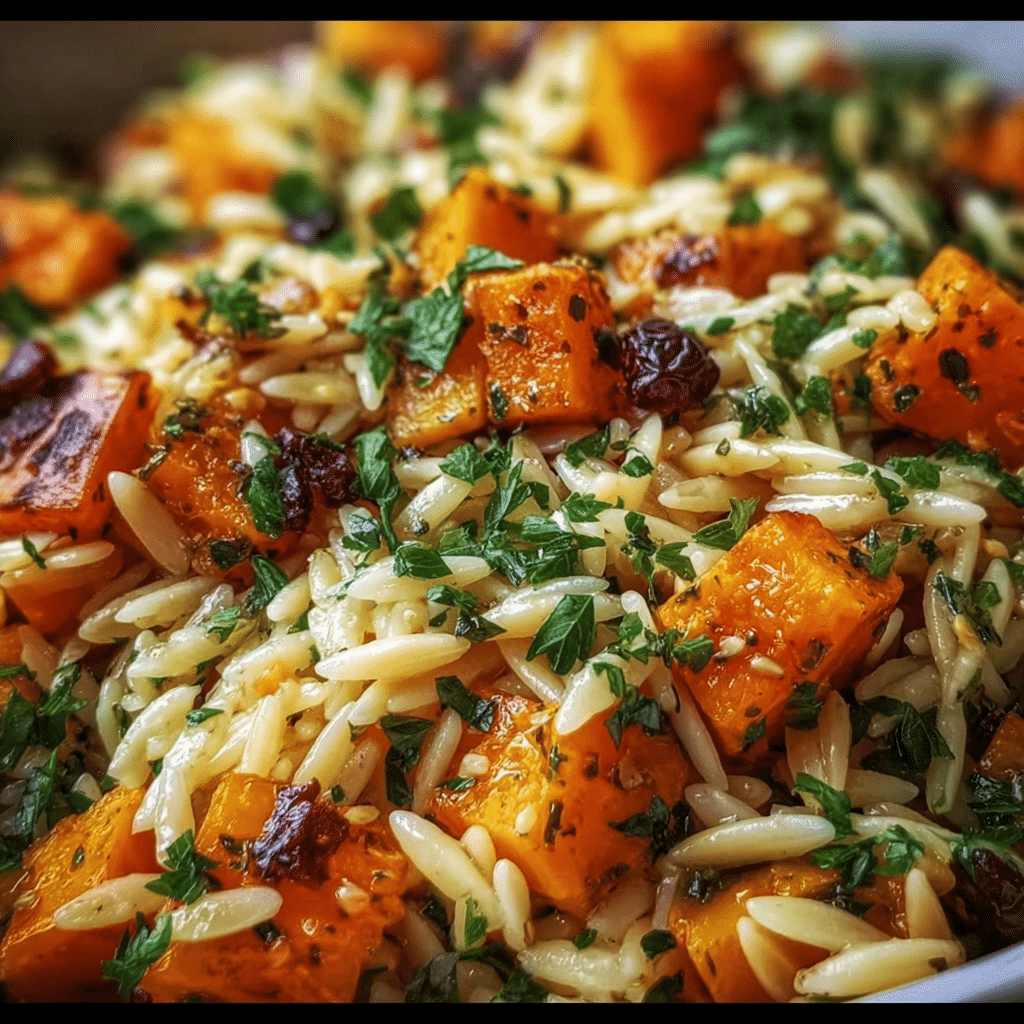
For a roasted butternut squash orzo salad with balsamic flavors, start with the same steps for roasting your squash and cooking the orzo. After combining these two main ingredients, prepare a balsamic dressing by whisking together balsamic vinegar, olive oil, Dijon mustard, a touch of honey, salt, and pepper. Pour this dressing over the salad and toss gently to coat everything evenly, allowing the squash to absorb some of the tangy flavors. To elevate the dish further, consider adding toasted walnuts or pecans for crunch and crumbled goat cheese for creaminess. This salad is perfect for a festive occasion or as a hearty side dish.
Orzo butternut squash feta
To make an orzo butternut squash salad with feta cheese, follow the basic recipe of roasting butternut squash and cooking orzo. After combining these ingredients, crumble feta cheese over the top for a salty contrast to the sweetness of the squash. You can also add a handful of cherry tomatoes for a juicy burst of flavor and some chopped red onion for a little bite. Drizzle with a light lemon vinaigrette to balance the richness of the feta, and serve it warm or at room temperature. This dish not only tastes delicious but also presents beautifully with the vibrant colors of the ingredients.
Orzo with roasted butternut squash and spinach Mediterranean diet
Orzo with roasted butternut squash and spinach fits perfectly within the Mediterranean diet by incorporating whole grains, healthy fats, and plenty of vegetables. Begin by roasting the squash and preparing the orzo as previously described. Once combined, fold in fresh spinach, which will wilt gently from the heat of the orzo and squash, adding both nutrients and a pop of color. For a Mediterranean twist, include ingredients like olives, artichoke hearts, and a sprinkle of feta cheese. Drizzle with extra virgin olive oil and a squeeze of lemon to enhance the flavors and nutritional benefits, making this dish a wholesome choice.
Butternut squash orzo goat cheese
To create a delicious butternut squash orzo salad with goat cheese, follow the basic steps for preparing the roasted squash and orzo. Once the two are combined, crumble creamy goat cheese on top for a tangy richness that pairs beautifully with the sweetness of the squash. Consider adding sautéed onions or garlic for additional depth of flavor, and toss in some fresh herbs like thyme or sage to complement the seasonal ingredients. For a finishing touch, drizzle with a balsamic reduction or a simple lemon vinaigrette for bright acidity. This dish makes a great main course or elegant side dish.
Creamy butternut squash orzo
For a creamy butternut squash orzo, you’ll want to incorporate a creamy element such as heavy cream, cream cheese, or a plant-based alternative after combining the roasted squash and orzo. Start by mashing some of the roasted squash into the orzo and gradually stir in your chosen cream until you reach your desired consistency. To enhance the flavor, add garlic powder, onion powder, or freshly grated Parmesan cheese, and season with salt and pepper. This comforting dish is perfect for fall and can be topped with toasted pumpkin seeds or nuts for added texture. Serve it warm as a filling main dish or a side.
Roasted butternut squash and orzo kale salad
To create a roasted butternut squash and orzo kale salad, start by roasting your cubed squash and cooking the orzo as usual. While these cool, massage fresh kale leaves with a bit of olive oil and salt to soften them and make them more palatable. Combine the roasted squash, orzo, and massaged kale in a large bowl, and consider adding ingredients like dried cranberries, nuts, or seeds for added texture and flavor. For a dressing, mix olive oil, apple cider vinegar, and a splash of maple syrup to enhance the sweetness of the squash. This hearty salad can be a satisfying main course or a delicious side dish for any meal.
Conclusion: Mastering the Perfect roasted butternut squash
Creating the perfect roasted butternut squash is more than just following a recipe—it’s about understanding the techniques, ingredients, and cultural significance behind this beloved dish. Throughout this comprehensive guide, we’ve explored everything from the historical origins to modern variations, ensuring you have all the knowledge needed to make this recipe your own.
Whether you’re a beginner cook or an experienced chef, the techniques and tips we’ve shared will help you create a roasted butternut squash that’s not only delicious but also meaningful. Remember that cooking is a journey of discovery, and each time you make this dish, you’ll learn something new.
We encourage you to experiment with the variations we’ve discussed, adapt the recipe to your dietary needs, and most importantly, share it with the people you love. Food has the incredible power to bring people together, and Roasted Butternut Squash Orzo Salad is the perfect dish to create lasting memories around your dinner table.

